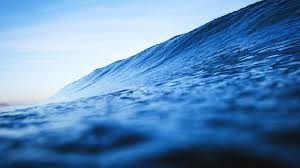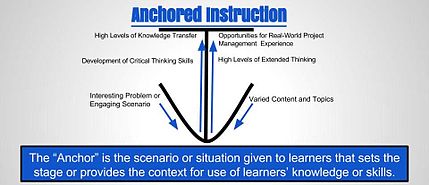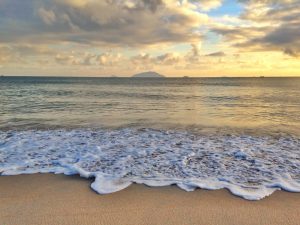
Introduction:
For my final analysis of learning for Mathematics and Science Classroom ETEC 533 I decided to use the metaphor of ocean waves. When I was learning to surf, it didn’t take long for me to realize that surfing is more than just hopping on a board and passively taking the ride, rather it is all about understanding the science of the waves. Similarly, educational technology is not just about playing around with the hardware or software. I have come to understand that what is most important, and what propels the learning about the technology, is the teacher’s ability to effectively use technology to develop students awareness of and ability to use problem-solving skills, teamwork and reflective thinking to solve problems.
In order to understand the metaphor I will break down the basics behind how a wave is created. The water in a wave does not generally move but instead acts as a flexible medium through which energy can transfer. There are many sources for this initial energy with wind being the most common. In my metaphor, the water drives the energy/knowledge to transfer to me to understand how technology can be efficiently used in the learning process. This analysis of my e-folio will explain the elements of a wave and how each component relates to my learning in this course. For me, the last part of my metaphor is the shoreline where the waves eventually hit. It represents my future and the obstacles I will face.
I have been anticipating and looking forward in taking this course since I was accepted into the MET program in January 2017. I eagerly mapped out my courses and I made sure that ETEC 533 would be offered before I graduated. As a generalist in elementary I am expected to teach in all four of the core academic areas. I am quite confident in teaching language arts and social studies because I focused on these in my undergraduate training. On the other hand, while I do enjoy both teaching and learning about math and science, I do not have much academic training in these areas and so am less confident in my capabilities. For this reason, I wanted to be sure that ETEC 533 was part of my program. In addition, I joined our school division’s Science, Technology, Engineering, Arts and Math (STEAM) cohort. Thus prepared, to continue the metaphor, I had my surfboard in hand and was ready to hit the waves to expand my knowledge, share my understandings, and develop a deeper appreciation of STEM.
Wave Crowding

For me, the best part of wave crowding is the point just before the large, surfable waves form. This is when the space between waves shortens and the energy begins to intensify. For me this is the time when I can reflect and take it all in. In my learning in this course, this period of wave crowding was represented by the first activity where we shared our earliest memory of using digital technology. I found auto-e-ography to be an excellent “ice-breaker” activity to surface our perspectives and prior knowledge of digital technologies. Having grown up in the 80s, I was excited to share my many early “techie-girl” experiences that started back in the 1980s. I also eagerly looked at many other individuals’ postings and was intrigued about which technologies made an impact on them in earlier in life and how. We all had different experiences, backgrounds and strengths (energy) that we brought to the group. We all knew there would be exciting things to come, but first we needed to set the stage and prepare.
While several people commented on my thread, I found Scott S.’s reply really piqued my interest as he questioned whether my “desire to be first [to own a technology]” was something that was in my nature, or whether this need to be first at something would have been there without technology? He even questioned whether I felt it was possible to differentiate.” Looking back now, I think the desire to delve into technology, in particular, has always been there. Recently, as a result of persistent encouragement from my colleagues, it became clear to me that I needed to harness my passion and fascination for technology and pursue it in higher education.
At the beginning of the course, we explored conceptual challenges and unpacking assumptions and how both the challenges and assumptions can impact the use technology in math and science learning environments. As I look back now at the videos, reading articles and postings about the conceptual challenges I notice that I was drawn to a couple of simple questions:
- What types of activities is technology suitable for?
- Is technology really necessary in the first place?
Vosniadou (1992) argued “we assume that [a] mental model is a dynamic structure which is created on the spot for the purpose of answering questions, solving problems, or dealing with other situations” (p. 543). In other words, selection and implementation of educational technology should be purposeful and planned. Additionally, educational technologies should be selected based on pedagogical principles with special considerations for math and science education. Following my analysis of my colleague’s interview and conducting my framing issue, I came to realize that good technology use can facilitate deeper and more meaningful learning. I came to realize that I sent out to ride the waves without a board (or with a boogie board instead of a surfboard) because I don’t feel you have a strong academic background understanding. Through my research on my framing issue assignment, it became evident that students, especially girls, are given the confidence to apply STEM concepts along with positive feedback in order to pursue careers in the field of STEM.
Wave Height Increases

Teachers create a learning environment that applies math and science concepts that are relevant, real-life situations and facilitate and supports their failures (when the wave height rises). During Module B, I felt the momentum of the waves beginning to increase as we learned a broad variety of technology resources to use for teaching STEM. I have to admit that, at first, it seemed a bit daunting with so many different applications and concepts. It felt a bit like when I was first learning to surf and I wondered, “How do we tackle these increasing waves with this big board?” But then we learned about teaching with the TPACK framework. It was a good place to start as it is used “pedagogical strategies and an analytic lens to study changes in educators’ knowledge about successful teaching with technology” (Mishra, P., & Koehler, M. J. 2006. p. 1046). Any experienced surfer is proficient at reading the waves and knowing when it is the right wave to try to catch. I found this be similar analogy when applying TPACK elements to enhance the learning and teaching experience, in other words trying finding that “sweet spot”. Studying the length and height of a wave in some ways parallel to the components of the TPACK model. For instance, while teachers are teaching the content using appropriate pedagogical methods and technologies, they need to have an intuitive understanding of the complex interaction between the three basic information components (CK, PK TK) (Schmidt et al. 2009).
As another wave increases, for the first time I was introduced to all four Technology Enhanced Learning Environments (TELEs)- (Anchored Instruction, LfU, SKI and TGEM). As Linn, Clark, Slotta (2011) explained TELEs prepare students to become lifelong learners “by engaging them in carrying out complex projects and regularly critiquing, comparing, revising, rethinking, and reviewing their ideas” (p. 532). By investigating each one, it became clear to me that I have employing this kind of active learning for some time and therefore the learning buoyed me up and build my confidence in my existing practice. For example, I used a previous photosynthesis lesson that included inquiry based aspects that drew upon both SKI theory and WISE research.
Overall, I can see benefits of using each of these learning environments in the science and/or math classroom. As a generalist elementary teacher, I gravitated to the following TELEs that I think would be suited for my grade three students, Anchored Instruction and Learning for Use-LfU. I often use videos in my classroom to anchor a concept or as a way to identify an expert. Ultimately, I find videos offer an engaging way of learning something new and prepares or provides the context to activate prior knowledge and critical thinking skills.

Additionally, the LfU learning environment is something I continually ask my student teachers to base their lessons on. The LfU model characterizes the development of useable understanding as a three-step process consisting of;
- motivation [recognition the limitations in one’s knowledge; assumes student is already reasonably engaged],
- knowledge construction [linking new knowledge structures to existing knowledge; can be firsthand experience, communication from others, or a combination of the two],
- knowledge refinement [knowledge is reorganized, connected to other knowledge, and reinforced to support its future retrieval and use]” (Edelson, D.C. 2001).
It is vital for me to explicitly show my student teachers how these LfU characteristics enhance the learning experience for the students. By following the LfU process makes it easy for students to gain interest, build knowledge and to make learning more visible.
Surf Zone: Crest

I was “riding the crest of the wave” going into Module C. According to the Collins Dictionary, “if you are on the crest of wave, it means that you are feeling very happy and confident because things are going well for you.” I would not go so far that I was absolutely confident with my skills in teaching and learning and digital technologies, rather I was buoyed up and felt lifted by the sense of excitement and intrigue I felt when I was immersed in topics such as how to incorporate visual stimulation, collaborative and realistic environments. As a result of my experiences in this module I solidified the conviction that embodied learning, knowledge diffusion, and information visualization have the potential to engage students in ways that help them make sense of math and science concepts, such as by making abstract concepts visible and providing students with alternate means of representing their thinking. Finkelstein, Perkins, Adams, Kohl, & Podolefsky (2005) note that PhET simulations “…are designed to be highly interactive, engaging, and open learning environments that provide animated feedback to the user…designed to build explicit bridges between students’ everyday understanding of the world and its underlying physical principles…” (p. 2). Pairing the TPACK framework with authentic simulations offers the opportunity to pair the learning of cognitives fact with a physical connection with the body as well. In saying that, the need for significant teacher training and the cost of implementation for such an approach could be potential obstacles as these implementations come with a cost. It was at this point that I discovered that such embodied learning applications as Gimozo are supported in my school division. Gizmos use an inquiry-based approach to learning to explore different simulations that can deepen conceptual understanding for students and promote problem-solving. Unfortunately, at this point in time, most of these open learning environments are more geared to upper grades with a limited number of activities for the lower elementary grades. As school divisions, including my own, continue to promote these realistic online environments, I believe the demand will create a push, increasing the numbers of activities being developed for younger students.
Wave Approach Shore

As I ride the whitewater waves to shore, it gives me time to reflect on my ETEC 533 experience and the implications it will have on my teaching practice. It was not that long ago I wrote my auto-e-ography and began delving into the modules and readings of this course. Now, I am spending time looking through a wide array of STEM resources that incorporate knowledge representation, information visualization, and the social and cognitive affordance of technology for learning. I am amazed at the the extent to which our 21st-century students, particularly girls, have embodied learning opportunities to not to just think about solutions, but rather to live the solution. I certainly hope to use them in my classroom in the future. Despite a couple stumbling blocks navigating through the course content, I found my experience to be positive and I feel I now have the necessary skills to implement Technology Enhanced Learning Experiences, ultimately providing my students with the best learning opportunities possible.
References:
Edelson, D.C. (2001). Learning-for-use: A framework for the design of technology-supported inquiry activities. Journal of Research in Science Teaching,38(3), 355-385.
Finkelstein, N.D., Perkins, K.K., Adams, W., Kohl, P., & Podolefsky, N. (2005). When learning about the real world is better done virtually: A study of substituting computer simulations for laboratory equipment. Physics Education Research,1(1), 1-8.
Linn, M., Clark, D., & Slotta, J. (2003). Wise design for knowledge integration. Science Education, 87(4), 517-538.
Meyer, A., Rose, D. H., & Gordon, D. T. (2014). Universal design for learning: Theory and practice. CAST Professional Publishing.
Mishra, P., & Koehler, M. J. (2006). Technological pedagogical content knowledge: A framework for teacher knowledge. Teachers college record, 108(6), 1017.
Schmidt DA, Baran E, Thompson AD, Mishra P, Koehler MJ, Shin TS 2009. Technological pedagogical content knowledge (TPACK): The development and validation of an assessment instrument for pre-service teachers. Journal of Research on Technology in Education, 42(2): 123-149.
Von Glasersfeld, E. (2008). Learning as a Constructive Activity. AntiMatters, 2(3), 33-49.
Vosniadou, S., & Brewer, W. F. (1992). Mental models of the earth: A study of conceptual change in childhood. Cognitive psychology, 24(4), 535-585.
